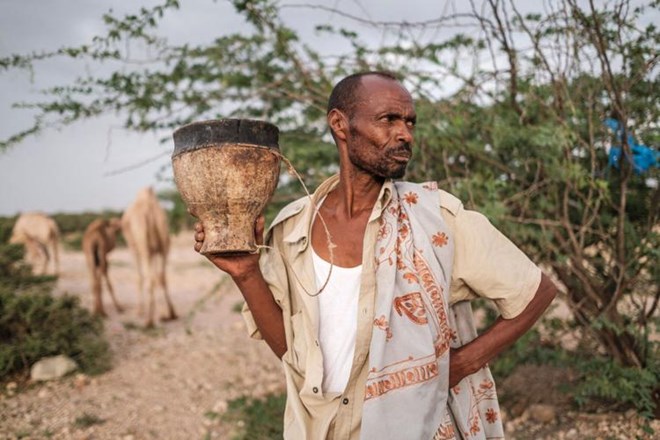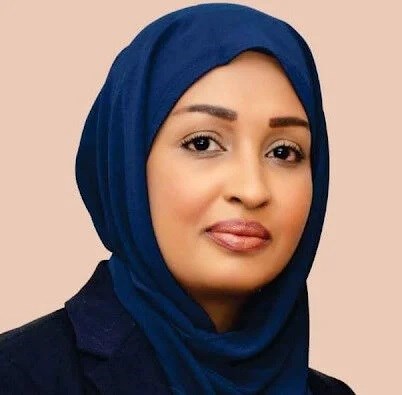Tuesday May 9, 2023
By Khadija Mohamed Al-Makhzoumi

Ali Abdi Elmi holds a cup filled with camel milk, in the outskirts of the city of Hargeisa, Somaliland, on Sept. 18, 2021. - For many Somalis, the camel is a gift from the gods: a source of milk and meat, a beast of burden in the desert and -- as climate change spurs extreme weather in the Horn of Africa -- insurance in times of crisis. An animal of haughty and cantankerous repute, in Somalia the camel is celebrated in songs and folklore, a symbol of status and prosperity, and exchanged in marriage or to settle feuds. In this overwhelmingly rural society of 15 million, the rearing of camels and other livestock underpins an economy devastated by war and natural disaster that ranks among the world's very poorest. (Eduardo Soteras/AFP via Getty Images/TNS)
I recently attended the Fifth United Nations Conference on Least Developed Countries, or LDCs, to make the case for urgent international support for Somalia’s struggle against climate change. I left feeling determined to continue drawing attention to the crippling drought and flooding at home, as well as a sense of shared purpose with other low-income countries that bear the least responsibility for climate change but are burdened with its heaviest impacts.
The LDCs account for 13% of the world’s population but only about 1.3% of global GDP and just a fraction of that when it comes to global emissions. Somalia has seen an unprecedented six consecutive rainy seasons fail. Half of the country, around 8 million people, now require humanitarian aid to survive, including 2.4 million children under 5 who are suffering acute malnutrition. The price of food has soared, while desertification is rapidly destroying what remains of arable land. An astonishing 1.3 million people are displaced by drought—80% of them women and children.
advertisements
Somalia is not alone in facing massive climate-forced displacement and migration. Recent findings show that over the coming decades, the African continent will see an increase in climate-forced migration and displacement, with up to 113 million people projected to become internally displaced by 2050, according to the recently published African Shifts report by the Africa Climate Mobility Initiative.While most African countries experience internal displacement, for my subregion, cross-border mobility exacerbates this urgent concern. Somalia, along with its neighbors in the Horn of Africa, are expected to see a sharp increase in cross-border climate mobility during this period; up to 55 million people in Eastern Africa could be on the move by 2050 in response to climate impacts.
What is already clear is that the scale and complexity of climate mobility require a whole-of-society approach to address them effectively. National policy and planning must be informed by a full understanding of the local challenges and ways to empower local communities. And countries must mobilize at all levels of the climate mobility ecosystem — the national government, local authorities, community leaders, businesses and other stakeholders — so that our people can stay, move, and resettle in dignity.
This inclusive approach is at the heart of our Somalia National Climate Change Policy and the recently adopted Environment Management Bill, which will ensure that resources to combat and cope with the impacts of global climate change reach the communities that need them. We will work with partners that have the necessary knowledge and expertise, like the Global Centre for Climate Mobility, to anticipate and plan for climate-forced migration and displacement as central to our national adaptation effort.
In that regard, I sincerely appreciated having Amy Pope, the U.S. candidate for director general of the International Organization for Migration (IOM), join me at COP27 in Sharm-El-Sheikh, Egypt, last November. Pope joined me again at the LDC Conference in March to underscore the importance of an evidence-based, people-centered approach to climate-forced migration and displacement. This is precisely what is needed for LDCs that face climate change.
Somalia is counting on international institutions led by those with experience on the front lines of climate change, vision and management skills (like Amy Pope) to ensure that these organizations help build locally anchored plans and solutions. We need Amy Pope to lead from the front and to join other LDCs in supporting her as the next leader of IOM.
 Khadija Mohamed Al-Makhzoumi is the Minister of Environment and Climate Change of Somalia.
Khadija Mohamed Al-Makhzoumi is the Minister of Environment and Climate Change of Somalia.